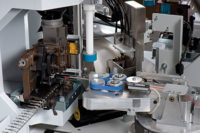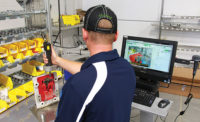Quick change is a popular type of magic in which performers appear in entirely different costumes within just a few seconds. It’s an act that takes tremendous skill and lots of practice to perfect.
The same thing is true in manufacturing. Whether the operation is a multistation automated assembly line, a semiautomatic riveting cell or a benchtop dispensing application, rapid changeover is critical to reducing production lot sizes, improving flow and maximizing profit.
Changeover also is an important component of lean manufacturing initiatives. But, in today’s high-mix production environment, it can create numerous challenges for engineers.
“The higher the mix, the more important changeover is,” notes Sammy Obara, president of Honsha Associates. “The complexity depends more on the process itself—factors such as number of internal steps, stabilization and validation—and not on the fact it is a high or low mix.”
Changeover is defined as the time it takes from the last accepted part being produced of one item to the first accepted part being produced of a different item. This includes disassembling the previous equipment and tooling setups, configuring any new setups, staging and verifying the materials required for the new item, adjusting any settings to their new required values, beginning production, and dialing in the first good part.
“In a simple sense, it is the time and activities spent from last good part to the next good part when an order change of some type occurs,” says Art Smalley, president of the Art of Lean Inc. and a former Toyota Motor Corp. engineer. “However, it is not always as straightforward as one might think.
“The hallmark of a lean changeover is one that is safe, simple and efficient,” claims Smalley. “If it is hard, dangerous or difficult, that’s a sign there is waste, inefficiency and overburden in the process that needs to be examined.
“Ideally, it helps improve flow and reduce downtime,” explains Smalley. “When changeover time is small and approaches zero, then you can level production (heijunka) more easily. That is true for the assembly line or a batch asset.”
Some manufacturers use the terms “changeover” and “setup” interchangeably. Typically, industries with large-scale equipment that runs more or less continuously tend to use changeover, while batch industries, such as job shops, tend to use setup. Most experts recommend using the term changeover when talking about switching between products and setup when referring to a machine or process.
“Changeover refers to the process of preparing [assembly lines] to produce a particular item,” says Quarterman Lee, president of Strategos Inc., and a former engineer at Boeing and Ford Motor Co. “Generally, it means switching from one item to another.
“I like to define it as the time required for this switching or preparation measured from the last item produced for the previous part number until the first acceptable subsequent part number is ready to start the operation,” explains Lee. “This will include any shutdown time for the previous part number; preparation of tooling; change out of raw material or component stocks; exchange of tooling; adjustments or fine tuning; trial runs; and quality checks, such as first-piece inspection.”
“Changeover is work that’s only done once to prepare to mass-produce another product,” says Richard Rahn, principal of Leonardo Group Americas, a consulting firm that specializes in lean manufacturing. “Setup really means work that has to be done for every piece or unit that’s produced, such as loading and unloading a stamping press.
“On an assembly line, changeover usually involves changing fixtures or materials,” Rahn points out. “But, there’s also a hidden form of changeover that some engineers fail to address. It has to do with the psychological adjustment that operators need to make when they start to assemble a different product.
“Part kitting is a great way to address this issue,” adds Rahn. “Assemblers don’t have to make as many decisions and it can result in a 5 percent productivity gain.”
Lean Role Player
Quick changeover is a key component of continuous flow. It provides the flexibility to match product mix to actual demand with as little inventory as possible.
“Changeover is critical to flow,” says Rahn. “That’s why it was one of the first things that Toyota worked on when it began its lean journey back in the 1950s. Engineers realized that unless you address changeover, the production process can’t flow.”
“Without good changeover strategies, you’re losing time in between product types,” warns Chris Lupfer, product sales manager for assembly technology at Bosch Rexroth Corp. “Lost time is lost money. This is waste. So, when you change over from product to product, you need to do it as quickly and efficiently as possible to maximize pull-through production and not lose money. How critical are good changeover strategies? Depending on your product offering, they might be a matter of survival.”
SMED (single-minute exchange of die) is the classic lean changeover model. It eliminates waste and reduces changeover time.
“The old SMED concept of internal vs. external work is still critical to grasp and understand,” notes Smalley. “Improving changeover is not a single event or a one-time activity. It is a multitude of small things that add up over time. It is sort of like compound interest. Keep making improvements every year and it can really add up over time.
“For large, asset-intensive industries, there is often extensive or variable down time associated with change over,” explains Smalley. “That can be a major factor in terms of capital productivity. Historically, set up reduction and changeover work improvement was something Toyota started working on 60 years ago in its stamping department.
“That work continued for decades as engineers reduced die set up time from several hours to under 10 minutes by the early 1970s,” Smalley points out. “The ability to change over effectively helps both equipment availability and improves flow of product in the value stream.”
“Changeover reduction helps to reduce batch sizes, thus enabling flow,” adds Philip Vaughan, senior consultant at Simpler Consulting Europe. “If we can cut changeover time in half, we can do twice as many. The creation of single-piece flow helps balance work processes to customer takt, which is a fundamental lean principle.”
One manufacturer that has fine-tuned its lean changeover strategy is R.W. Lyall & Co., a leading producer of oil and gas pipeline components, such as fittings, meters, valves and protective enclosures. Most of its products are custom designed and fabricated.
The company subscribes to a continuous improvement process called the Lyall Business System, which is modeled on the Toyota Production System. R.W. Lyall assembles its products at two ISO-9001 plants located in Corona, CA, and New Berlin, WI.
Lyall’s machines are designed from the start, or retrofitted in kaizen events, to separate internal from external changeover tasks, visually manage and pre-stage external setup tasks, reduce threaded fasteners, and replace adjustments with fixed set points.
“Any changeover that takes longer than a single takt time will create discontinuity on the assembly line,” says Steven Bell, manager of continuous improvement and industrial engineering at R.W. Lyall. “In a lean value stream, this affects downstream processes, as well as the timing of pull signals upstream.
“Efforts to buffer against this by batching, or holding extra safety stock, create other types of waste,” warns Bell. “Once you achieve your objective in getting changeover minutes to single-digit performance, the next objective should be single takt time changeovers.”
Bell and his colleagues use multiple lean techniques to ensure flexibility, including visual management, standard work and rightsized equipment.
“The most important thing you can do to accommodate product changeover is to ensure that your work environment is visually managed and controlled,” claims Bell. “Waiting or looking for tools, materials or information on what needs to be done next is often one of the largest categories of changeover time. It’s also low-hanging fruit—the easiest part of changeover reduction to eliminate.”
At R.W. Lyall, the current best method for each item produced is recorded on a standard work combination sheet that describes all the production steps. A
diagram shows the configuration of workcells and the pattern that the operators use to flex between stations in the cells.
“In some cells, the sheets are used to add, remove and position equipment as well,” Bell points out. “Our best practice is to compile these sheets into a playbook that’s owned by the lead of the cell. When there’s a changeover, the lead flips to the correct sheet in the playbook and orchestrates the play.”
Many of R.W. Lyall’s assembly machines are developed in-house based on 3P (production, preparation, process) principles. According to Bell, most of the equipment is “simple, speed aligned with takt time, has a single function, is portable (90 percent or more have casters) and interchangeable with other production cells.”
High-Mix Myths
Today’s high-mix production world is putting extra pressure on engineers to address changeover. In fact, it’s now more important than ever.
“The demand for changeovers has increased, but so have the awareness, techniques, tools and capabilities necessary to meet the challenge,” says Bell. “The single biggest impediment remains the traditional cost accounting mindset that incentivizes long runs and extended overseas supply chains over flexibility and vertical integration.”
“The higher the mix, the more important changeover is,” notes Sammy Obara, president of Honsha Associates. Obara spent three years studying lean manufacturing principles in Toyota City, Japan, and another 10 years applying it at Toyota assembly plants in Brazil, Venezuela and the United States.
“The complexity depends more on the process itself—factors such as number of internal steps, stabilization and validation—and not on the fact it is a high or low mix,” Obara points out. “That said, for high-mix production, you have to pay added attention to external steps.
“For example, you have a very short production time until you have to change to product B, then again, a short production time until you start product C,” adds Obara. “This means that during these short moments of production, you must prepare all the external steps for the next changeover. This requires good common sense and experience.”
Changeover isn’t always more difficult in high-mix production environments. But, depending on the number of different parts involved and the assembly complexity that’s required, it may take more time and thought to develop a system.
According to Smalley, high-mix assembly lines don’t necessarily make the changeover process more difficult. “What is changing is the frequency of the requirement,” he explains. “If we only make black Model Ts, then changeover is pretty simple.
“However, as you try to create more options or flavors for the customer, that increases the quantity of changeover work that has to be performed,” notes Smalley. “That requires careful thought in design of the product, process and production scheduling system, just to name a few things.”
“Every scenario is different,” says Bosch Rexroth’s Lupfer. “For example, instead of a workstation with different areas of parts to grab from for different parts, you may want to have mobile supply stations that need to be wheeled in or rotated to provide proper parts and ergonomic reach. That’s a simple example, but it requires thought and ergonomic analysis to build the carts.
“If you imagine a scenario in which an RFID tag is placed on the operator’s ID badge so that the workstation can adjust automatically to the worker’s height, you’re adding new planning requirements,” notes Lupfer. “But, if you keep your eye on the ultimate goal—the fastest possible changeovers—analysis of what’s needed typically sorts itself out pretty easily.”








